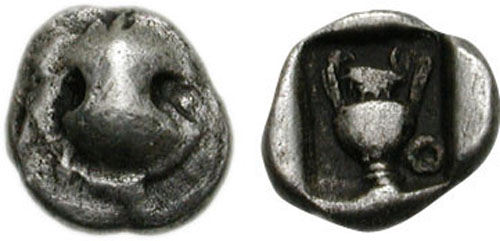SO 508 - Thebes over Aegina
From SILVER
470 BCE - 440 BCE | Θ
Images
Overstriking coin

Thebes_shield_amphora.jpg [1]
Location/history
| Sale(s)Sale(s) ᵖ: | Classical Numismatic Group, Triton IX, 10 Jan. 2006, n°372. | |
Overstriking coin
Description
| ObverseInscription or printing placed on the obverse.: | Boiotian shield. | ReverseInscription or printing placed on the reverse.: | Θ (Greek) Amphora within incuse square. |
Mint and issuing power
| MintIdentifies the place of manufacture or issue of a numismatic object.: | Thebes | Ancient regionAncient region. | Boeotia | Modern countryModern country: Greece | AuthorityIdentifies the issuing power. The authority can be "pretended" when the name or the portrait of X is on the coin but he/she was not the issuing power. It can also be "uncertain" when there is no mention of X on the coin but he/she was the issuing power according to the historical sources: |
Chronology
| FromIdentifies the initial date in a range assigned in a numismatic context. 470 BCE toIdentifies the final date in a range assigned in a numismatic context.. 440 BCE | Classical 480-323 BC |
Physical description
| MetalThe physical material (usually metal) from which an object is made.: Silver |
WeightWeight of the numismatic object (in grams). in grams: 0.260.26 g <br />260 mg <br /> | DenominationTerm indicating the value of a numismatic object. Examples: tetradrachm, chalkous, denarius.: tetartemorion |
|
| StandardStandard.: Aeginetic | |||
References
| Coin referenceReference of the Coin: | HGC, n°1376 | Coin series referenceReference to coin series study: | Babelon 1901-19321Babelon 1901-1932, Tome 3, Part 2,, HGC 42HGC 4, n°1376 |
| Coin series web referenceCoin series web references: | |||
Overstruck type
Description
| ObverseInscription or printing placed on the obverse.: | Turtle (visible on obverse). | ReverseInscription or printing placed on the reverse.: | Incuse square with 'mill-sail' device |
Mint and issuing power
| MintIdentifies the place of manufacture or issue of a numismatic object. ᵖ: | Aegina | Ancient regionAncient region. ᵖ | Aegina | Modern countryModern country: Greece | AuthorityIdentifies the authority in whose name (explicitly or implicitly) a numismatic object was issued. ᵖ: |
Chronology
| FromIdentifies the initial date in a range assigned in a numismatic context. 525 BCE toIdentifies the final date in a range assigned in a numismatic context.. 475 BCE | Classical 480-323 BC |
Physical description
| DenominationTerm indicating the value of a numismatic object. Examples: tetradrachm, chalkous, denarius. ᵖ: | tetartemorion |
StandardStandard. ᵖ: | Aeginetic |
References
| Coin type referenceReference to coin series study ᵖ: | SNG Delepierre3SNG Delepierre, n° 1580-1589, HGC 64HGC 6, n° 429, Meadows (forthcoming)5Meadows (forthcoming), Groups IIa-IIc. | ||
| Coin series web reference overstruckCoin series web references overstruck: | |||
Additional data
| Frequency of overstrikesFrequency of overstrikes: | frequent | Level of confidenceLevel of confidence of the identification: | strong |
| RemarksRemarks: | "Overstruck on an Aegina tetartemorion (the turtle showing under the shield)." | ||
